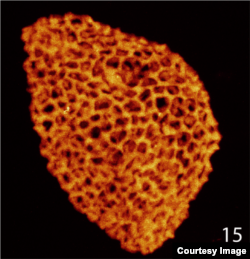A scientist has been searching for the origin of flowering plants, which evolved to dominate our landscape and define life as we know it. He reports his findings in a new study that pushes back the date of the earliest flower by 100 million years, to a period when dinosaurs roamed the earth.
Twenty-five years ago, geologist Peter Hochuli was on an expedition in Norway when he made a discovery in a sediment core - a long round sample of soil or rock - that puzzled him.
“And there I found first these amazing pollen grains which looked to me like the ones that I knew from the Cretaceous,” he said.
That is the relatively warm geological period 140 million years ago, when dinosaurs dominated the landscape, and scientists believe new groups of mammals and birds, as well as flowering plants, appeared. The problem was that he had dated the core to the Triassic, or 100 million years earlier in earth’s history.
“But for many of my colleagues, it didn’t fit the picture that these pollen are occurring in the middle Triassic. So I thought they were contaminants, and I suspected that they came from the lab. In the lab they also prepared Cretaceous sediments. So I also thought they made kind of a mess,” said Hochuli.
But he does not think so anymore. Now a paleo-botanist at the University of Zurich, Hochuli has focused his research on finding the origin of flowering plants, which evolved from extinct plants related to today’s conifers, seed ferns and pollen.
Hochuli works with organic fossils, those leaves, woody particles, spores and pollen extracted from sediment cores. His new study in the journal Frontiers in Plant Science describes pollen extracted from sediment cores in Switzerland. Interestingly, the date is consistent with his earlier suspicions more than two decades ago.
“I think that it is the direct line in the evolution of flowering plants. We are sure that the assemblages of the pollen and spores we found, they are about 240 million years old,” said said Hochuli.
The finding extends the uninterrupted sequence of fossilized pollen from flowers by 100 million years. Hochuli said his previous study in 2004 documented different, but clearly related, flowering plant-like pollen from the Barents Sea, some 3,000 kilometers away.
“And I think they are more widespread and more common than we originally thought. Originally we thought that this Barents Sea area would be kind of the cradle of the flowering plant evolution, but that is certainly not the case,” said Hochuli.
Charles Darwin described the origin of plants as an “abominable mystery,” because they appeared to spread across the earth in such a relatively short time. While Hochuli’s work pushes the date back, he said gaps remain and the record is spotty.
“I’m searching for the roots. I’m searching for a group of plants, which are at the base of the flowering plants,” he said.
Hochuli said more fossil evidence is needed to confirm his findings, a task he committed his life to find.
Twenty-five years ago, geologist Peter Hochuli was on an expedition in Norway when he made a discovery in a sediment core - a long round sample of soil or rock - that puzzled him.
“And there I found first these amazing pollen grains which looked to me like the ones that I knew from the Cretaceous,” he said.
That is the relatively warm geological period 140 million years ago, when dinosaurs dominated the landscape, and scientists believe new groups of mammals and birds, as well as flowering plants, appeared. The problem was that he had dated the core to the Triassic, or 100 million years earlier in earth’s history.
“But for many of my colleagues, it didn’t fit the picture that these pollen are occurring in the middle Triassic. So I thought they were contaminants, and I suspected that they came from the lab. In the lab they also prepared Cretaceous sediments. So I also thought they made kind of a mess,” said Hochuli.
But he does not think so anymore. Now a paleo-botanist at the University of Zurich, Hochuli has focused his research on finding the origin of flowering plants, which evolved from extinct plants related to today’s conifers, seed ferns and pollen.
Hochuli works with organic fossils, those leaves, woody particles, spores and pollen extracted from sediment cores. His new study in the journal Frontiers in Plant Science describes pollen extracted from sediment cores in Switzerland. Interestingly, the date is consistent with his earlier suspicions more than two decades ago.
“I think that it is the direct line in the evolution of flowering plants. We are sure that the assemblages of the pollen and spores we found, they are about 240 million years old,” said said Hochuli.
The finding extends the uninterrupted sequence of fossilized pollen from flowers by 100 million years. Hochuli said his previous study in 2004 documented different, but clearly related, flowering plant-like pollen from the Barents Sea, some 3,000 kilometers away.
“And I think they are more widespread and more common than we originally thought. Originally we thought that this Barents Sea area would be kind of the cradle of the flowering plant evolution, but that is certainly not the case,” said Hochuli.
Charles Darwin described the origin of plants as an “abominable mystery,” because they appeared to spread across the earth in such a relatively short time. While Hochuli’s work pushes the date back, he said gaps remain and the record is spotty.
“I’m searching for the roots. I’m searching for a group of plants, which are at the base of the flowering plants,” he said.
Hochuli said more fossil evidence is needed to confirm his findings, a task he committed his life to find.











